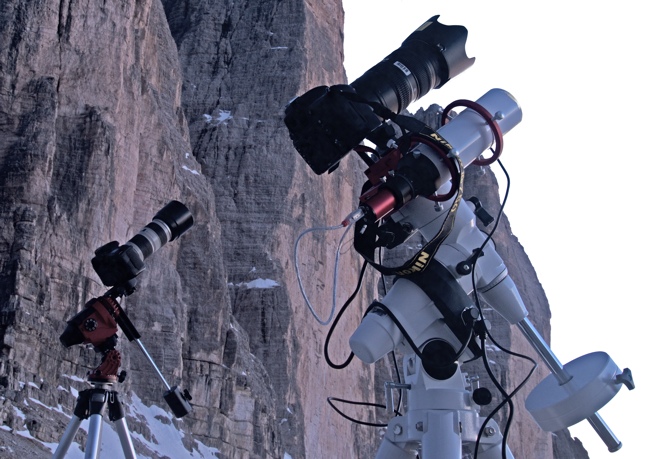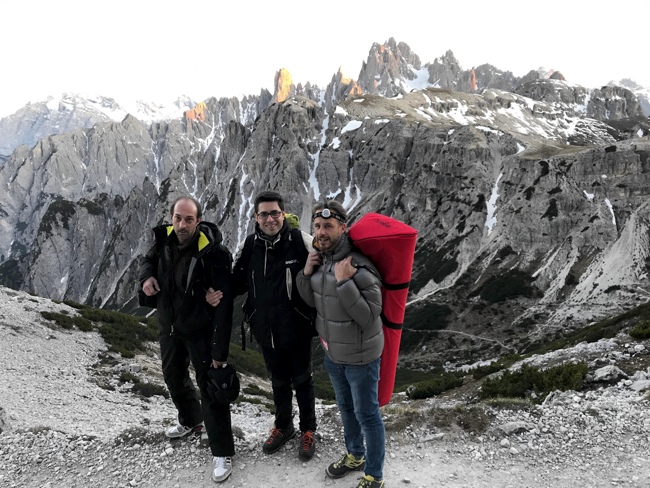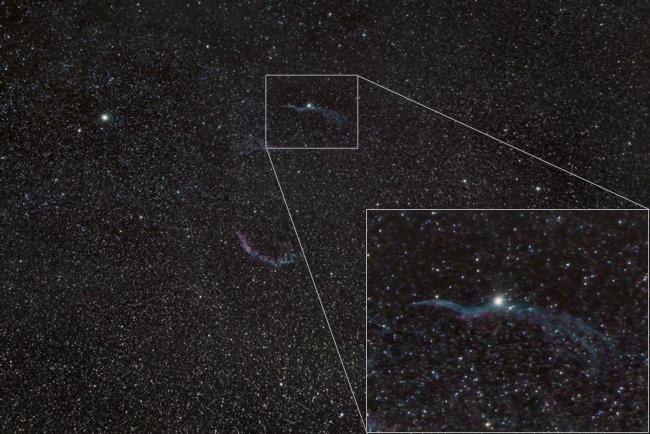Star Adventurer versus EAGLE CORE kit: astrophotography with DSLR camera
Star Adventurer and EAGLE CORE kit allow you to track the apparent motion of the stars in the sky and, if you have a DSLR camera, allow you to record long exposures of deep-sky objects such as galaxies, nebulae or star clusters. But how long? In fact, the longer the exposition time that our instrumentation will allow us to have, the “deeper” our pictures will be, and the better we will record deep-sky objects. We then compared the Star Adventurer and EAGLE CORE highlighting advantages and disadvantages of each solution using a Nikon D750 DSLR camera and Nikon AF-S 70-200mm f/2.8 G ED VR telephoto lens to record pictures.
DSLR cameras revolutionized digital astrophotography and, thanks to the exceptional technological evolution of sensors and image processors, they also greatly perform very long exposures with high ISO sensitivity, still having a very low background noise. So they’re also the perfect choice for those who want to perform long exposure astrophotography without going to the complexity of CCD cooled astronomy camera (which nevertheless offer even higher performances). But the camera is not enough: in fact, in order to track the apparent motion of objects in the sky, the normal photo tripod is not enough and you need to have a special instrument. Amateur astronomers with their telescopes always use equatorial mounts but, starting a few years ago, also the “star trackers” are used, including the famous Star Adventurer by SkyWatcher. Essentially a star tracker works like an equatorial mount but:
1) The star tracker is installed on a normal photo tripod, it’s small and lightweight so it is easier to transport. But it has a much lower load capacity than a real equatorial mount. This generally means that you can install DSLR camera with telephoto lenses but hardly telescopes (except those that are particularly compact and light).
2) The equatorial mount is larger and heavy but also more stable, so it supports not only real telescopes but also the heaviest telephoto lenses withDSLR camera. On the other hand, they are more difficult to transport even if are available compact models and bags to facilitate transport.

3) a star tracker usually has a single axis motor (the AR one) while the equatorial mount can be motorized in both axes (AR and DEC) and may also have an ST4 auto-guide port. Then the equatorial mount can be equipped with an autoguide system that corrects the normal tracking errors of the equatorial mount. Even the Star Adventurer has an autoguide port, but with only the Right Ascension motor, the autoguide works only in this axis and fails to perfectly correct the tracking errors (which of course occur also in Declination axis).
4) Equatorial mounts, especially if they are computerized, cost more than the Star Adventurer but have advanced features such as automatic goto thanks to an integrated database of many objects (eg the SkyWatcher equatorial mounts have a database of more than 40,000 objects). This allows you to automatically point to the objects we want to photograph, while with a star tracker you need to manually point them and then perfectly know the position in the sky.
In order to compare the performances of Star Adventurer and EAGLE CORE we moved to one of the most beautiful places in the world, the Tre Cime di Lavaredo in the Dolomites having with us a Star Adventurer installed on a solid photo tripod with the dedicated equatorial head (that allows for precise polar alignment) and the EAGLE CORE complete kit with SkyWatcher EQ5 equatorial mount.

Both the Star Adventurer and the EAGLE CORE kit are much more portable than a classic telescopes, so thanks to Geoptik transport bags, we could walk on the path that connects the Auronzo hut (where we left the car) to Forcella Lavaredo that we reached in about 1 hour. So we prepared both instruments and waited for astronomical twilight to start astrophotography. It is true that these are not VERY compact tools but they have proved to be easily transportable allowing us to reach fantastic places and with very little light pollution.

We started our test by making the most accurate Star Adventurer polar alignment thanks to the dedicated dedicated equatorial wedge. Then we installed the Nikon D750 camera with theNikon AF-S 70-200mm f/2.8 G ED VR telephoto lens (set at 200mm f/4) and started shooting the star Alkaid in the Constellation of the Big Bear (center in the below picture, in the upper right you can see the M51 galaxy, the left galaxy M101). Our StarAdventurer allowed us to record up to 2 minutes of exposition time, the 3 minutes picture shows the stars clearly elungated (picture below).

We then installed the Nikon D750 withNikon AF-S 70-200mm f/2.8 G ED VR telephoto lens (always set at 200mm f/4) on the EQ5 SynScan mount with the EAGLE CORE kit and made a series of longer exposures. The built-in autoguide system allows EAGLE CORE to automatically correct tracking errors. Thanks to this system it is possible not only to take longer exposition images but also to take a sequence of many photographs that can then be stacked together during processing. In this way, we can photograph very weak objects and therefore we wanted to record the entire Nebula Veil in the Swan, thanks to the huge Full Frame (36 x 24mm) sensor of the Nikon D750. We recorded 6 images of 5 minutes each, then we stacked them to get the result below. As you can see from the enlarged area, tracking is perfect and stars are perfectly point-like.

SkyWatcher Star Adventurer is surely the most portable instrument you can find and use for long exposure astrophotography but is also limited in the length of expositions you can record and the weight (camera + telephoto lens) that it can load. EAGLE CORE along with a compact equatorial mount is less portable than a Star Adventurer but it offers a very high tracking accuracy, equal to the one you can get by a real astrophotography telescope. In addition, the use of a computerized equatorial mount makes it easy to point the objects to be photographed, which can also be done by connecting EAGLE CORE to the mount and using the SkySafari app to point the objects from your smartphone or tablet. With the Star Adventurer, pointing (and focusing on the image) are definitely more complicated and we were often lying on the ground trying to point the object in the sky!
EAGLE CORE, at a higher price than a Star Adventurer, therefore offers superior performance and is therefore not only for anyone looking for a photo system without any limitation but also for those who already have a Star Adventurer and want to take pictures with better results!

